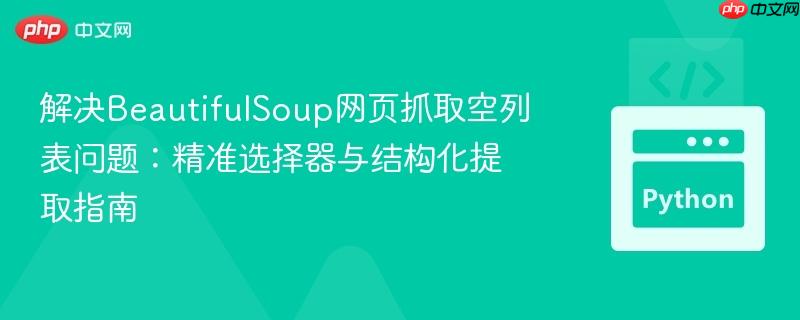
本教程深入探讨使用BeautifulSoup进行网页抓取时,因选择器不当导致返回空列表的常见问题。我们将分析传统find()方法可能遇到的陷阱,并重点介绍如何利用CSS选择器进行精确元素定位,通过迭代文章容器实现结构化数据提取,从而有效解决数据抓取失败的问题。
在使用BeautifulSoup进行网页数据抓取时,一个常见的困扰是最终得到一个空列表。这通常不是因为网站反爬虫机制过于严苛(尽管这也会发生),而是由于HTML元素选择器未能准确匹配到目标内容。当BeautifulSoup无法根据提供的选择器找到任何匹配的元素时,它会返回None或者一个空的列表/结果集,进而导致后续的数据提取操作失败。理解并正确使用选择器是解决此类问题的关键。
我们首先来看一个导致空列表的典型代码示例及其潜在问题:
import requests
from bs4 import BeautifulSoup
url = 'https://inshorts.com/en/read/technology'
news_data = []
news_category = url.split('/')[-1]
headers = {'User-Agent': 'Mozilla/5.0 (Windows NT 10.0; Win64; x64) AppleWebKit/537.36 (Windows NT 10.0; Win64; x64) AppleWebKit/537.36 Chrome/91.0.4472.124 Safari/537.36'}
data = requests.get(url, headers=headers)
if data.status_code == 200:
soup = BeautifulSoup(data.content, 'html.parser')
headlines = soup.find('div', class_=['news-card-title', 'news-right-box'])
articles = soup.find('div', class_=['news-card-content', 'news-right-box'])
if headlines and articles and len(headlines) == len(articles):
news_articles = [
{
'news_headline': headline.find_all('span', attrs={'itemprop': 'headline'}).string,
'news_article': article.find_all('div', attrs={'itemprop': 'articleBody'}).string,
'news_category': news_category
}
for headline, article in zip(headlines, articles)
]
news_data.extend(news_articles)
print(news_data)上述代码旨在从inshorts.com抓取新闻标题和文章内容。然而,它常常返回一个空列表。分析其原因,主要有以下几点:
为了解决上述问题,我们推荐使用更强大、更灵活的CSS选择器。BeautifulSoup通过select()和select_one()方法支持CSS选择器,它们可以帮助我们更精确地定位元素。核心思路是:
以下是优化后的代码,展示了如何利用CSS选择器高效地提取数据:
import requests
from bs4 import BeautifulSoup
url = 'https://inshorts.com/en/read/technology'
news_data = []
news_category = url.split('/')[-1]
headers = {'User-Agent': 'Mozilla/5.0 (Windows NT 10.0; Win64; x64) AppleWebKit/537.36 (Windows NT 10.0; Win64; x64) AppleWebKit/537.36 Chrome/91.0.4472.124 Safari/537.36'}
data = requests.get(url, headers=headers)
if data.status_code == 200:
soup = BeautifulSoup(data.content, 'html.parser')
# 使用CSS选择器定位所有新闻文章的父级容器
# 根据inshorts网站结构,每个新闻文章通常有一个itemtype属性
for article_container in soup.select('[itemtype="http://schema.org/NewsArticle"]'):
headline_element = article_container.select_one('[itemprop="headline"]')
article_body_element = article_container.select_one('[itemprop="articleBody"]')
# 确保元素存在,避免NoneType错误
if headline_element and article_body_element:
news_data.append(
{
'news_headline': headline_element.get_text(strip=True),
'news_article': article_body_element.get_text(strip=True),
'news_category': news_category
}
)
print(news_data)代码解释:
当使用BeautifulSoup进行网页抓取时遇到空列表问题,核心原因通常在于HTML元素选择器的不准确性。通过对原始代码的分析,我们发现find()方法的局限性、选择器不精确以及文本提取方式的误用是导致问题的主要因素。
解决方案在于采用更强大、更精确的CSS选择器,并结合结构化的数据提取策略。首先定位包含目标数据的父级容器,然后遍历这些容器,并在每个容器内部使用更具体的选择器提取所需信息。同时,进行适当的空值检查和文本清洗是保证爬虫健壮性和数据质量的关键。遵循这些最佳实践,可以显著提高网页抓取的成功率和效率。
以上就是解决BeautifulSoup网页抓取空列表问题:精准选择器与结构化提取指南的详细内容,更多请关注php中文网其它相关文章!

每个人都需要一台速度更快、更稳定的 PC。随着时间的推移,垃圾文件、旧注册表数据和不必要的后台进程会占用资源并降低性能。幸运的是,许多工具可以让 Windows 保持平稳运行。

Copyright 2014-2025 https://www.php.cn/ All Rights Reserved | php.cn | 湘ICP备2023035733号